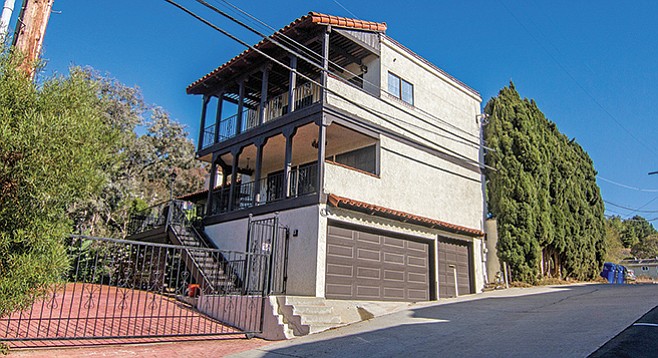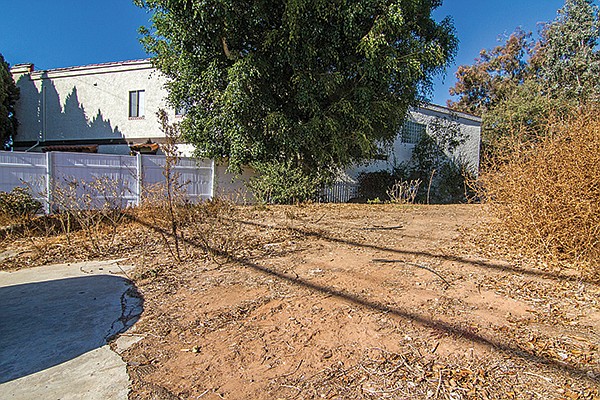 Facebook
Facebook
 X
X
 Instagram
Instagram
 TikTok
TikTok
 Youtube
Youtube

The Spanish villa that Virginia LaGuardia and her husband built in the 1970s may soon be nestled against a massive parking garage, student housing, and an administrative building that the University of San Diego intends to build.

During the course of the past several years, the university’s planning department has kept busy. The school has bought every parcel of land surrounding LaGuardia’s home on Josephine Street, down the hill toward Linda Vista Road on the south side of the campus. It then petitioned the city to allow it to expand its footprint to make room for what is projected to be an addition of 922,000 square feet of new buildings and student housing.
When the expansion is complete, the college will be allowed to increase enrollment from 7000 undergraduate students (8905 when factoring in graduate programs) to 10,000 undergraduate students.
According to the newly adopted master plan, a six-story parking garage could be built about 30 feet from LaGuardia’s bedroom window, a three-story student dormitory could be built across a narrow alley from LaGuardia’s garage door, and an administrative building could be located just feet from her back porch.

For now, these remain preliminary, or, as the university calls them, conceptual plans. But because they are a part of the university’s master plan, the city will allow administrators to proceed as they wish and require the most basic approval.
“The Master Plan provides a framework for how the university might be developed over the next twenty years. However, without funding, these plans are merely conceptual,” writes a University of San Diego spokesperson.
“Once the City has confirmed the projects conforms with the Conditional Use Permit and Master Plan, we would then pursue the necessary permits. At this time, University of San Diego does not have any specific plans for developing Josephine Street. As you read in the Master Plan, possibilities range from a residential building, to a parking structure or an academic building.”
But while conceptual, the parking garage, student apartment complex, and the academic building all appear within a few hundred feet of LaGuardia’s home on the map that the city approved earlier this year.
The main problem, says LaGuardia, is that the university can now decide what to build and where, and she has very little to say about it.
The university will not have to conduct additional environmental review or traffic studies.
LaGuardia feels the university has not acted in good faith and says the planning department hopes to drive down the price of her home to eventually force her hand in selling the land. She says the city is doing nothing to protect her.
University administrators first announced the expansion plans in 2014. In order to expand, staff was required to update the university’s 1996 master plan. That proposal allowed the university to identify 16 new structures to be built.
In fact, since the 1996 master plan was approved, the university has built two parking garages, a new basketball arena, the Kroc Institute for Peace and Justice, two dormitories, a baseball stadium, and three other academic buildings.
The update to the plan adds 14 structures to the list. Those plans include construction of four large administrative buildings, four student apartment buildings, and a new athletics building, among other projects.
La Guardia says she was willing to participate and was happy that the university was growing. But then she began hearing the university was buying up the parcels surrounding her. Then she saw a map of the master plan; on it, dotted lines indicating the college boundaries jutted out to Linda Vista Road. Just north of Linda Vista Road, nestled in between a parking garage, a new administration building, and student apartment complex, was a tiny triangle-shaped parcel, which was her house. She soon asked the planning department for more information and learned of the possibility that a 150-car parking garage could go in less than 38 feet from her bedroom window and a four-story student housing building could end up less than 12 feet from her front windows.
University officials approached LaGuardia and offered to buy her house, whose hillside perch offers panoramic views of Mission Bay, Old Town, Mission Valley, and Mission Hills beyond, for three college scholarships in her name and $475,000.
She scoffed at the offer.
Not long after, LaGuardia says communications between her and university planners stopped.
“We bought a little shack on the hill in ’76 when my husband was the director of development [at USD],” LaGuardia said during a recent phone interview. “We held alumni parties here, and now, this....
“This is my primary asset. My husband is dead. If you put a parking garage behind me, what am I going to do? It’s going to be like living in a hole.... I asked them why they have to shove it against my house. The only real reason is to make my house less valuable. Who would ever want to buy a house with a six-story parking garage right on top of them?
“I’ve gone through the hurt and disappointment, but now I have no other choice but to hit them in the head with the lawsuit.”
LaGuardia did just that on October 12. Her attorney, Craig Sherman, says the city has violated the California Environmental Quality Act by allowing the university to move forward with only conceptual plans.
“The city and the University of San Diego are playing it fast and loose whereby they say ‘conceptual,’ but they want all final approvals rubber-stamped with no project-specific discretionary or [environmental] review,” Sherman said during an October interview.
“The city is presenting and arguing it both ways. They approve enormous conceptual [plans] but lock in development entitlements, while at the same time deferring environmental review and impacts, basically saying that it will figure it all out later.”


The Spanish villa that Virginia LaGuardia and her husband built in the 1970s may soon be nestled against a massive parking garage, student housing, and an administrative building that the University of San Diego intends to build.

During the course of the past several years, the university’s planning department has kept busy. The school has bought every parcel of land surrounding LaGuardia’s home on Josephine Street, down the hill toward Linda Vista Road on the south side of the campus. It then petitioned the city to allow it to expand its footprint to make room for what is projected to be an addition of 922,000 square feet of new buildings and student housing.
When the expansion is complete, the college will be allowed to increase enrollment from 7000 undergraduate students (8905 when factoring in graduate programs) to 10,000 undergraduate students.
According to the newly adopted master plan, a six-story parking garage could be built about 30 feet from LaGuardia’s bedroom window, a three-story student dormitory could be built across a narrow alley from LaGuardia’s garage door, and an administrative building could be located just feet from her back porch.

For now, these remain preliminary, or, as the university calls them, conceptual plans. But because they are a part of the university’s master plan, the city will allow administrators to proceed as they wish and require the most basic approval.
“The Master Plan provides a framework for how the university might be developed over the next twenty years. However, without funding, these plans are merely conceptual,” writes a University of San Diego spokesperson.
“Once the City has confirmed the projects conforms with the Conditional Use Permit and Master Plan, we would then pursue the necessary permits. At this time, University of San Diego does not have any specific plans for developing Josephine Street. As you read in the Master Plan, possibilities range from a residential building, to a parking structure or an academic building.”
But while conceptual, the parking garage, student apartment complex, and the academic building all appear within a few hundred feet of LaGuardia’s home on the map that the city approved earlier this year.
The main problem, says LaGuardia, is that the university can now decide what to build and where, and she has very little to say about it.
The university will not have to conduct additional environmental review or traffic studies.
LaGuardia feels the university has not acted in good faith and says the planning department hopes to drive down the price of her home to eventually force her hand in selling the land. She says the city is doing nothing to protect her.
University administrators first announced the expansion plans in 2014. In order to expand, staff was required to update the university’s 1996 master plan. That proposal allowed the university to identify 16 new structures to be built.
In fact, since the 1996 master plan was approved, the university has built two parking garages, a new basketball arena, the Kroc Institute for Peace and Justice, two dormitories, a baseball stadium, and three other academic buildings.
The update to the plan adds 14 structures to the list. Those plans include construction of four large administrative buildings, four student apartment buildings, and a new athletics building, among other projects.
La Guardia says she was willing to participate and was happy that the university was growing. But then she began hearing the university was buying up the parcels surrounding her. Then she saw a map of the master plan; on it, dotted lines indicating the college boundaries jutted out to Linda Vista Road. Just north of Linda Vista Road, nestled in between a parking garage, a new administration building, and student apartment complex, was a tiny triangle-shaped parcel, which was her house. She soon asked the planning department for more information and learned of the possibility that a 150-car parking garage could go in less than 38 feet from her bedroom window and a four-story student housing building could end up less than 12 feet from her front windows.
University officials approached LaGuardia and offered to buy her house, whose hillside perch offers panoramic views of Mission Bay, Old Town, Mission Valley, and Mission Hills beyond, for three college scholarships in her name and $475,000.
She scoffed at the offer.
Not long after, LaGuardia says communications between her and university planners stopped.
“We bought a little shack on the hill in ’76 when my husband was the director of development [at USD],” LaGuardia said during a recent phone interview. “We held alumni parties here, and now, this....
“This is my primary asset. My husband is dead. If you put a parking garage behind me, what am I going to do? It’s going to be like living in a hole.... I asked them why they have to shove it against my house. The only real reason is to make my house less valuable. Who would ever want to buy a house with a six-story parking garage right on top of them?
“I’ve gone through the hurt and disappointment, but now I have no other choice but to hit them in the head with the lawsuit.”
LaGuardia did just that on October 12. Her attorney, Craig Sherman, says the city has violated the California Environmental Quality Act by allowing the university to move forward with only conceptual plans.
“The city and the University of San Diego are playing it fast and loose whereby they say ‘conceptual,’ but they want all final approvals rubber-stamped with no project-specific discretionary or [environmental] review,” Sherman said during an October interview.
“The city is presenting and arguing it both ways. They approve enormous conceptual [plans] but lock in development entitlements, while at the same time deferring environmental review and impacts, basically saying that it will figure it all out later.”
Comments